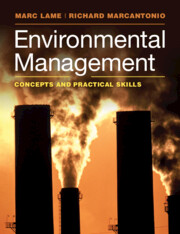Refine search
Actions for selected content:
36809 results in Cambridge Textbooks
Index
-
- Book:
- The Economics of Developing and Emerging Markets
- Published online:
- 16 December 2022
- Print publication:
- 01 December 2022, pp 527-538
-
- Chapter
- Export citation

Environmental Management
- Concepts and Practical Skills
-
- Published online:
- 30 November 2022
- Print publication:
- 22 September 2022
-
- Textbook
- Export citation
6 - Combined Systems and System Modeling Techniques
-
- Book:
- Dynamic Systems
- Published online:
- 28 April 2023
- Print publication:
- 24 November 2022, pp 396-501
-
- Chapter
- Export citation
Appendices
-
- Book:
- Dynamic Systems
- Published online:
- 28 April 2023
- Print publication:
- 24 November 2022, pp 758-777
-
- Chapter
- Export citation
1 - Introduction
-
- Book:
- Dynamic Systems
- Published online:
- 28 April 2023
- Print publication:
- 24 November 2022, pp 1-15
-
- Chapter
- Export citation
Index
-
- Book:
- Dynamic Systems
- Published online:
- 28 April 2023
- Print publication:
- 24 November 2022, pp 778-786
-
- Chapter
- Export citation
Appendix B - A Brief Introduction to MATLAB and Simulink
-
- Book:
- Dynamic Systems
- Published online:
- 28 April 2023
- Print publication:
- 24 November 2022, pp 761-770
-
- Chapter
- Export citation
7 - System Response Analysis
-
- Book:
- Dynamic Systems
- Published online:
- 28 April 2023
- Print publication:
- 24 November 2022, pp 502-588
-
- Chapter
- Export citation
3 - Mechanical Systems
-
- Book:
- Dynamic Systems
- Published online:
- 28 April 2023
- Print publication:
- 24 November 2022, pp 114-221
-
- Chapter
- Export citation
9 - Application Problems
-
- Book:
- Dynamic Systems
- Published online:
- 28 April 2023
- Print publication:
- 24 November 2022, pp 666-757
-
- Chapter
- Export citation
2 - Fundamentals of Mathematics
-
- Book:
- Dynamic Systems
- Published online:
- 28 April 2023
- Print publication:
- 24 November 2022, pp 16-113
-
- Chapter
- Export citation
Acknowledgments
-
- Book:
- Dynamic Systems
- Published online:
- 28 April 2023
- Print publication:
- 24 November 2022, pp xiii-xiv
-
- Chapter
- Export citation
5 - Thermal and Fluid Systems
-
- Book:
- Dynamic Systems
- Published online:
- 28 April 2023
- Print publication:
- 24 November 2022, pp 334-395
-
- Chapter
- Export citation
4 - Electrical Systems
-
- Book:
- Dynamic Systems
- Published online:
- 28 April 2023
- Print publication:
- 24 November 2022, pp 222-333
-
- Chapter
- Export citation
Appendix A - Units and Conversion Table
-
- Book:
- Dynamic Systems
- Published online:
- 28 April 2023
- Print publication:
- 24 November 2022, pp 758-760
-
- Chapter
- Export citation
8 - Introduction to Feedback Control Systems
-
- Book:
- Dynamic Systems
- Published online:
- 28 April 2023
- Print publication:
- 24 November 2022, pp 589-665
-
- Chapter
- Export citation
Preface
-
- Book:
- Dynamic Systems
- Published online:
- 28 April 2023
- Print publication:
- 24 November 2022, pp ix-xii
-
- Chapter
- Export citation
Contents
-
- Book:
- Dynamic Systems
- Published online:
- 28 April 2023
- Print publication:
- 24 November 2022, pp v-viii
-
- Chapter
- Export citation
Appendix C - A Brief Introduction to Wolfram Mathematica
-
- Book:
- Dynamic Systems
- Published online:
- 28 April 2023
- Print publication:
- 24 November 2022, pp 771-777
-
- Chapter
- Export citation
Copyright page
-
- Book:
- Dynamic Systems
- Published online:
- 28 April 2023
- Print publication:
- 24 November 2022, pp iv-iv
-
- Chapter
- Export citation
